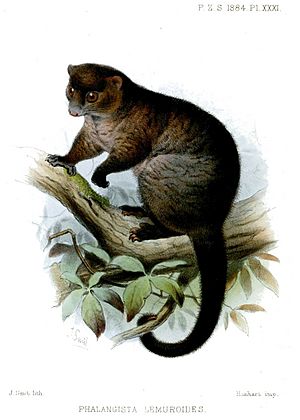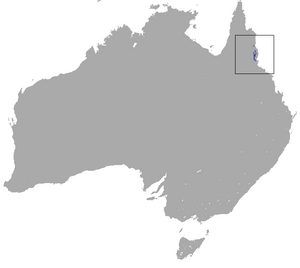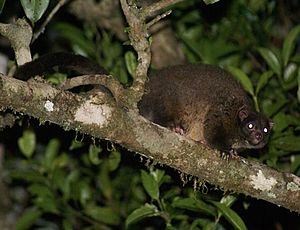Lemuroid ringtail possum facts for kids
Quick facts for kids Lemuroid ringtail possum |
|
|---|---|
 |
|
| Conservation status | |
| Scientific classification | |
| Genus: |
Hemibelideus
|
| Species: |
lemuroides
|
 |
|
| Lemuroid ringtail possum range | |
The lemuroid ringtail possum (Hemibelideus lemuroides) is a special type of ringtail possum. People also call it the lemur-like ringtail possum or the brushy-tailed ringtail. It was once thought to be a greater glider, but it's actually quite different! Its scientific name, Hemibelideus, means "half-glider."
This possum is named for its face, which looks a bit like a lemur! It has a short nose, big eyes that face forward, and small ears. Like other gliding possums, it's built for jumping through trees. Its long, prehensile tail (meaning it can grip things) helps it live high up in the trees.
What They Look Like
The lemuroid ringtail possum has a bushier tail than other ringtails. You can tell it apart from the greater glider because it doesn't have a gliding membrane. Its ears are also much shorter and don't have much hair.
These possums are social animals, meaning they live in groups. They come in two main colors. Most are brownish-gray with a yellowish belly. There's also a rare white form. This white possum used to live in the Daintree Rainforest. It was last seen in 2005 and 2008, and people worried it might be almost gone.
Where They Live
This special possum lives in a small area of Queensland, Australia. You can find them between the towns of Ingham and Cairns. There's also a separate group living on the Mount Carbine Tableland. Both these areas are part of the Wet Tropics World Heritage Area.
Lemuroid ringtail possums live only in trees. They prefer the very tops of tall, old trees in forests. They usually live at high elevations, between 480 and 900 meters (about 1,500 to 3,000 feet) above sea level. An adult possum is about 30–38 centimeters (12–15 inches) long, with a tail of 30–35 centimeters (12–14 inches). They weigh between 810 and 1140 grams (about 1.8 to 2.5 pounds).
Facing the Heat
Scientists like Stephen Williams from James Cook University study these possums. He noticed that after big heat waves in 2005, very few lemuroid possums were seen for several years. Slowly, they started to recover. In 2009, three were spotted in the Daintree National Park. Scientists thought the white possums would recover just like the brown ones.
However, another heatwave hit in November 2018. The Cairns area had the hottest temperatures ever recorded. Even high up in the mountains, it reached 39 °C (102 °F). Many animals in tropical areas can't handle extreme heat. They haven't developed ways to cool themselves down. Temperatures above 29 degrees Celsius (84 °F) can be deadly for them.
Over the last 15 years, some animal species have started to disappear from lower areas. This means their total numbers are going down. They are forced to live in smaller areas at higher elevations. This puts a lot of pressure on animals like the lemuroid possum that live on mountain tops. They have nowhere else to go, as the nearest rainforest is very far away.
See also
 In Spanish: Falangero lemuroide para niños
In Spanish: Falangero lemuroide para niños



